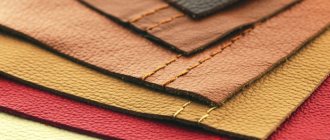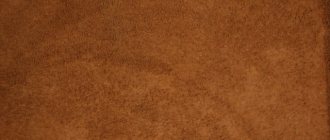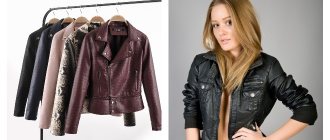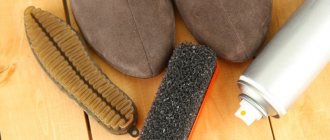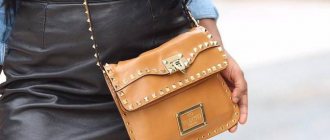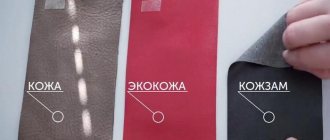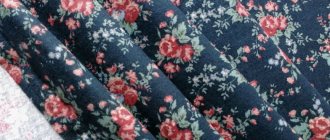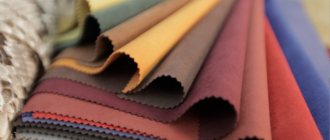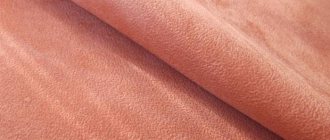Updated: 04/23/2021 15:26:24
Expert: Dina Shulman
The modern textile industry regularly uses the latest polymer materials. This is due to the fact that they are cheaper and often more beautiful than natural ones, and in terms of performance properties they are not inferior to the “original”. And this is especially evident in “leather” products.
Thus, clothes, shoes and accessories made of genuine leather are attractive and durable, but at the same time they are very expensive and are not suitable for convinced vegetarians and vegans. To correct these two problems, the textile industry often produces alternatives that retain both the design and quality of its predecessor. The most popular of them are eco-leather and artificial leather (leatherette).
In this article we will look at the difference between eco-leather and artificial leather – and what is better to use.
Eco leather
Eco-leather is a fairly new material that is highly technological. It is based on a polyurethane mass, but it is not the only substance in the structure. Eco-leather is a multi-layer material with very good performance properties.
So, eco-leather is characterized as follows:
- It is very wear resistant. Does not crumble, wear out or change color over time. Things made from it are resistant even to exposure to sunlight - they do not dry out or turn yellow under ultraviolet radiation;
- It is breathable. That is, it has a “breathing” effect. Thanks to this, the body under clothes does not sweat and does not “evaporate” at high temperatures. It is also useful in shoe making;
- It's elastic. Clothes and shoes “adjust” to the individual anatomical features of the wearer, without causing discomfort or unpleasant sensations. Of course, this is not a reason to take shoes two sizes smaller, but some sneakers or eco-leather sneakers will feel much more pleasant;
- It imitates the texture of natural leather. Does not differ from natural material either visually or to the touch. At the same time, it remains soft, which makes things made from it even more comfortable;
- It is hypoallergenic;
- It's inexpensive.
In addition to polyurethane or polypropylene itself, eco-leather also contains cotton or natural leather shavings. Polymers serve only as a connecting link. And most importantly, the polyurethane and polypropylene that make up eco-leather are environmentally friendly and do not cause irritation.
The only drawback of the polymer base is the relatively small operating temperature range. However, with everyday use it is unlikely to go beyond its limits. Polymers begin to be damaged at temperatures below -35 degrees or above 100 degrees.
All this provides a very wide range of applications for eco-leather. It is used to make clothing, upholstery of furniture and objects (for example, car seats), accessories and shoes. Eco-leather varieties vary in softness. For example, haberdashery is more rigid - so that handbags and purses keep their shape better.
So, let's summarize.
Advantages
- Realistic texture, almost indistinguishable from the natural version;
- Softness, firmness and elasticity. All this increases the reliability and durability of products;
- In the production of some types of eco-leather, natural crushed leather is used.
Flaws
- Easily scratched, especially when in contact with abrasives - including during cleaning or similar processing;
- Extremely unstable to cutting influences, easily pierced;
- The layered structure of eco-leather can lead to the fabric base being visible through defects on the top decorative film.
In general, eco-leather items are comfortable, practical and durable. The only complaint about this material is the insufficient strength of the top layer, due to which it is easily cut and scratched by abrasives. But if worn or used carefully, things made from eco-leather will please the eye for a long time.
By the way, eco-leather can be “modified” with various additives. That is, they distinguish cold-resistant, high-strength, heat-resistant, resistant to acids and alkalis, reinforced and several other varieties.
Genuine Leather
Among the advantages of natural material are:
- environmental friendliness - no unpleasant odor, no toxic emissions when exposed to heat;
- practicality - stains from leather products are removed with a damp cloth or wet sponge with a small amount of detergent;
- aesthetics - it is accessories made of genuine leather that speak of the good taste of the owner and his high income;
- originality - if your leather jacket is slightly worn or has scratches, this is not a reason to part with it - such a thing with a touch of vintage will look even more sophisticated and stylish;
- thermal insulation – leather outerwear is very warm even in the absence of additional insulation.
Are there any disadvantages to natural materials? There are few of them:
- high cost, but this disadvantage neutralizes one of the advantages - durability;
- hygroscopicity – when wet, a leather product gains weight, but special water-repellent impregnations prevent this.
If you have enough money for something made of genuine leather, feel free to make such a purchase.
Faux leather
Artificial leather (leatherette or leatherette) is also a polymer material, only polyvinyl chloride is used as the base. It is relatively safe and can take on any texture. But the main advantage of polyvinyl chloride (PVC) is that it has a natural, soft shine.
In addition, faux leather is also a multi-layer material. A sheet of foamed PVC is placed on a reinforcing fabric sheet. That is why leatherette is quite reliable and flexible at the same time.
Artificial leather is characterized as follows:
- Average wear resistance. PVC, even foamed, is a rather brittle material. Therefore, the surface of leatherette at bends and joints cracks over time, and sometimes even comes off in pieces;
- High density. Artificial leather does not allow air to pass through, as a result of which clothes and shoes made from it can cause discomfort and unpleasant sensations. One of the most important problems is that a person in such things begins to sweat, regardless of the temperature outside (that is, the natural thermoregulation of the epidermis is disrupted);
- Low softness and elasticity. Leatherette is quite hard and rough to the touch, that is, comparable to dried and “shrunken” natural leather. The problem is not only the unpleasant tactile contact, but also the roughness of the material itself. And leatherette does not stretch;
- Quite realistic imitation of the texture of natural leather. Due to the flexibility of PVC, the artificial material easily reproduces the natural texture - all these hair and blood channels, tubercles and depressions. However, manufacturers rarely take advantage of this advantage, creating too uniform and uncomplicated patterns - it’s cheaper;
- Hypoallergenic;
- Low price.
It is worth noting that the operating temperature range of artificial leather is even lower than that of its environmentally friendly version. PVC becomes very fragile already at -15 degrees and “tans” quite strongly in the cold, so it is better to wear sheepskin coats and jackets made from this material in the autumn-spring period and not touch it in winter. Polyvinyl chloride is also very sensitive to high temperatures - it begins to deform already at 60 degrees, and at 65 it begins to release harmful substances. Of course, it is quite difficult to deal with such heat in a domestic environment - but it is better not to dry artificial leather shoes next to a heater.
Quite average performance parameters lead to the fact that artificial leather is practically not used in the production of clothing and shoes - except for the most low-quality and budget models. But it is often used for upholstery of upholstered furniture and interior items. So, a couple of decades ago, entrance doors covered with artificial leather were widespread.
So, let's summarize.
Advantages
- Low price. Faux leather is one of the cheapest options in its segment;
- Waterproof. It is impossible to get wet in clothes or shoes made of artificial leather. And spilled liquid on a sofa or chair with leatherette upholstery can be simply collected with a dry cloth;
- Resistance to external aggressive factors. Leatherette easily tolerates contact with acids, alkalis, dyes and other “chemicals”.
Flaws
- Rigidity and lack of elasticity. This makes clothes and shoes made from this material at least uncomfortable to wear;
- Fragility. Faux leather cracks in many cases. For example, at bends and joints - and this is a natural process. In addition, it “crumbles” with frequent abrasive contacts and does not tolerate prolonged friction;
- It “dumbs” in the cold, cracks easily in frost from -5 degrees.
In principle, artificial leather is quite comparable to a material such as linoleum. Only it has a protective layer that prevents abrasion, while leatherette does not. Otherwise, the structure of these two materials is very similar.
Due to all of the above disadvantages and, in principle, very average performance qualities, artificial leather is now used only in upholstery of upholstered furniture and haberdashery. Clothes and shoes are practically not made from it.
Distinctive characteristics of real leather
This is not only environmentally friendly, but also relatively wear-resistant, durable and airtight material. Depending on the processing method and the original carrier of the skin, the following types are distinguished:
- Suede - boasts a pleasant softness to the touch and low pile.
- Chevro - has a pronounced grain, elasticity, wavy edges and due to this it looks very impressive.
- Lacquered - can be either smooth or embossed, but always remains flexible, elastic, remarkably stretchy and shiny.
- Shagreen - its surface is fine-grained, with an interesting natural pattern and beautiful relief.
What is better – eco-leather or artificial leather?
So, eco-leather is a modern technological material, which consists of 75% natural raw materials, is practical and comfortable. But artificial leather can boast only of low price and resistance to aggressive factors. But the difference between the two materials does not stop there.
| Characteristics | Eco leather | Faux leather |
| Structure | 75% natural raw materials (cotton, crushed leather), 25% polymers | More than 75% foamed polyvinyl chloride, the rest is a reinforcing layer of fabric |
| Abrasion resistance | Only if there is no abrasive effect | Easily damaged |
| Temperature stability | Can be worn in cold weather | Cannot be worn in cold weather |
| Breathability | Yes, porous material | No, it causes sweating |
| Water permeability | Yes, it allows water to pass through | No, it repels water |
| Resistance to external aggressive factors | Resistant to sun, not resistant to chemicals | Not resistant to the sun, resistant to “chemicals” |
| Scope of application | Clothing, shoes, haberdashery, furniture | Haberdashery, furniture |
In general, it is better not to choose clothes and shoes made of artificial leather (leatherette, leatherette). But it is suitable for furniture upholstery - except that you have to take into account the abrasion and fragility of the material.
Leather bag or not
This is the thing you always take with you. Moreover, while wearing it, it may get exposed to rain or snow. After all the adventures, it must maintain its aesthetic appearance: remain attractive in a new way, not become cracked or wrinkled. This will not happen if the accessory is made from a material of natural origin.
You don't even have to subject the bag to numerous tests - just study the information (and graphics) presented on its label. This is a small sticker on which it is written what the top, lining, and decorative elements are made of. Any self-respecting manufacturer is obliged to indicate this data, and if it is not there, this is a fake.
Material structure
If you have any doubts, be sure to feel the accessory, both outside and inside. From the inside out, natural raw materials are always fleecy, while artificial ones are usually smooth. There should also be a light fluff on the front side, so that after contact with the palm, the shade of the suede or shagreen surface should change slightly.
Another method that tells you how to identify natural leather and distinguish it from artificial leather (leatherette), and is related to the structure, is simple weighing. The same dermantine is much lighter than skin, and you will see the difference on such a relatively small object as a bag.
Appearance and cuts
- Evaluate the edges and folds of the item. For a material of natural origin, they will most likely be thick and rounded, while for an imitation material they will likely be relatively thin and flattened.
- Check the inside again, but this time paying attention to the structure. A textile base without fibers is a sure sign of a fake.
- Look how well the seams are made - a self-respecting brand carefully hides all the cuts, not to mention the craftsmen of design houses.
Let's summarize what genuine leather looks like. It can be smooth or fleecy, but it always remains grainy, with a chaotic pattern and different pore sizes. Its color is even and quite rich, but not overly bright even after the most intense dyeing. Its shade does not change at the edges and folds.
The Piquadro online store offers only natural leather bags, suitcases and accessories, which are of high quality, long service life and durability.
In the article you learned how and how artificial leather differs from natural leather. Check products carefully and beware of counterfeits.
Sheep leather
Genuine leather made from sheep skins has narrower areas of application and, in comparison with calf leather, is used for sewing products less widely. However, in terms of its beauty, quality indicators and consumer characteristics, it is not inferior to the more popular types of cattle leather, often surpassing them in many important parameters. As a rule, high-quality sheep leather is extremely elastic, quite durable, extremely beautiful and very valuable.
The production of leather sheepskin involves skins that are unsuitable for processing into fur and fur coats. These include skins with wool shorter than the specified standards, as well as skins with heterogeneous or sparse hair. These indicators are a disadvantage and make it impossible to use such skins in fur production, but they turn into an advantage in tanning, since too much hair often causes looseness of the resulting leather.
Sheep skins entering the tanning industry are used primarily for the production of two types of leather - sheepskin, obtained from the skins of adult sheep, and chevrette, obtained from the skins of young lambs. Despite the difference in the age of the animals, sheep leather is characterized by a relatively small skin area and an average thickness of 0.4 to 0.8 mm.
This natural leather is very elastic, extremely pliable and incredibly soft. The combination of these qualities guarantees that things made from it will always be light, soft and breathable. In addition, sheepskin and chevrette lend themselves well to processing and retain their given shape for a long time, which is why experienced leatherworkers often prefer to use these varieties for the production of exclusive clothing, hats and various accessories. Compared to the more common and affordable cattle leather, sheepskin has a higher price and is most often used for sewing expensive clothes for individual orders.
Cattle leather
Cattle leather is the most common type of natural leather for sewing a wide range of products. Most of it is produced from the skins of large domestic cattle and, less frequently, from the skins of wild animals of related species. This leather is characterized by special density, elasticity and high strength properties. Various dressing technologies make it possible to obtain high-quality natural leather from cattle hides, resistant to constant mechanical and climatic influences.
Based on its origin, such leather is divided into several varieties: the skin of calves of various ages, young bulls, adult cows, bulls, oxen and buffaloes. In the case of cattle leather, its belonging to each of these groups is of key importance, since the age and sex of the animal largely determine the characteristics and quality indicators of the resulting material. The classification of leather raw materials of this type by gender and age is also based on one of the most important parameters taken into account when sewing and using products - the thickness of the finished leather. It can vary from 05mm for some types of calfskin to 5.5mm for the thickest bull. Despite the fact that in order to achieve the necessary parameters, the method of tanning cattle leather is extremely important and often very critical, in relation to the origin of the raw materials it is of secondary importance, since no processing will produce high-quality calf leather for sewing haberdashery from bovine or buffalo intended for production trunks and belts.
The most expensive and highest quality cattle leather always has a natural face and is subjected to minimal technological influences during the tanning process. More budget and affordable varieties go through various stages of mechanical face correction and, as a rule, have a more universal purpose and wider scope of application. However, regardless of the type of dressing and the depth of processing, almost all cattle leather has a unique set of quality indicators that meet the requirements of a wide variety of production and consumer needs. The universal characteristics of leather raw materials produced from cattle skins make it possible to equally successfully produce automobile, furniture, clothing, haberdashery, shoe, and industrial leather from it. In addition, some varieties of such leather have extremely narrow or specific areas of application, so it is almost impossible to find a replacement for them among similar types of leather obtained from the skins of other animals.
You can learn more about the types, characteristics and features of the use of this type of leather from a separate article entirely devoted to cattle leather.
Skin Benefits
Let me start with the first option when talking about which is better, leather or synthetics. The skin is worth giving in to only because it is where it all began. It is the first material that was used to make football boots. Previously, there were no special alternatives, but as it turned out, even with their presence, the skin remains very relevant.
Let's go through the main advantages of genuine leather:
- guarantees a perfect fit on the foot;
- allows you to feel the ball perfectly;
- breathes well;
- takes any shape to create a top design;
- lives for a long time without losing its quality properties;
- can be painted any color;
- has light weight.
Leather boots
Even today, many classic silhouettes continue to be made from leather. This happens more due to the fact that other materials cannot always replicate the properties of leather. Yes, there are synthetics, which in their properties almost completely correspond to the quality of leather, but here the question of price arises.
Sometimes it is more economically profitable not to come up with anything new and use the old proven production method. For some manufacturers, this is easier than investing in the development of new materials, testing them and sewing new models.
Sometimes even purchasing new versions of synthetics based on the patent of other developers is not always profitable in terms of financial costs. In some cases, leather comes out cheaper than synthetics, or prices even out, plus or minus.
Leather processing technologies also do not stand still. They learned to make leather with different properties, adapting it to any task. It can already be made an order of magnitude lighter, more elastic and thinner. But such improvements, again, come down to money. Only select brands can afford them.
